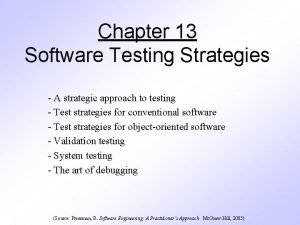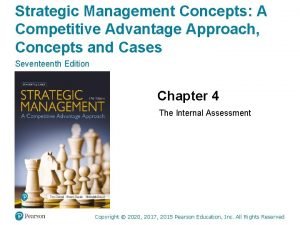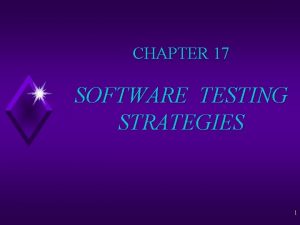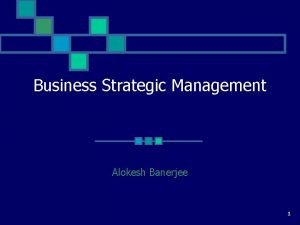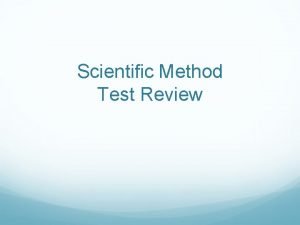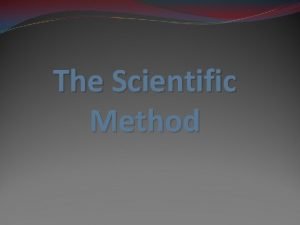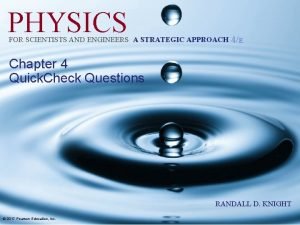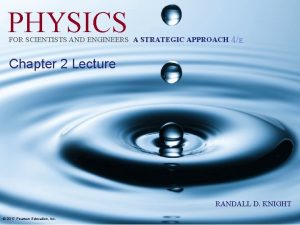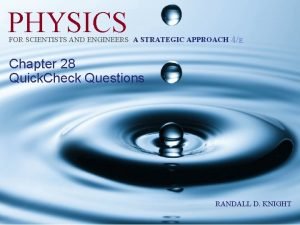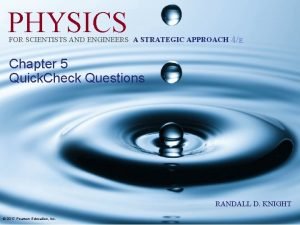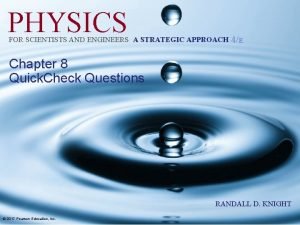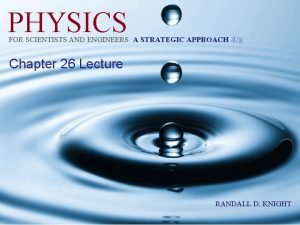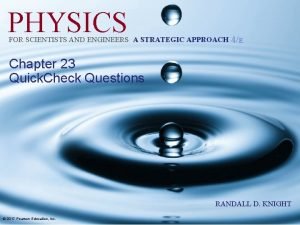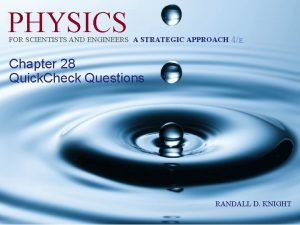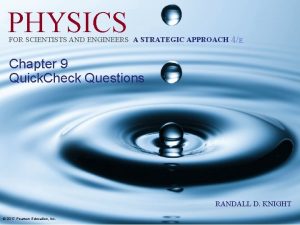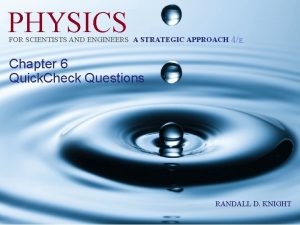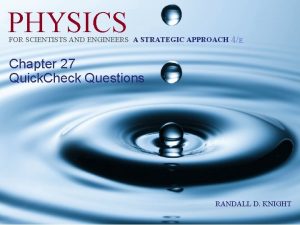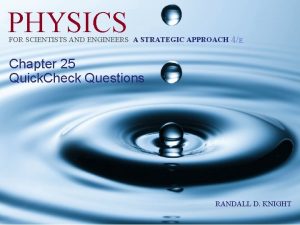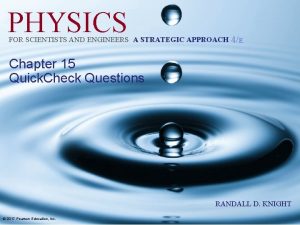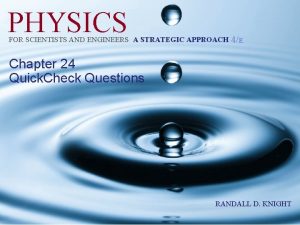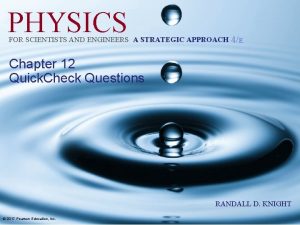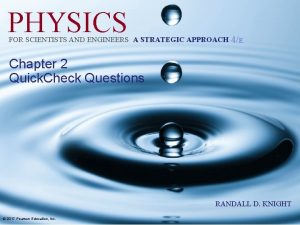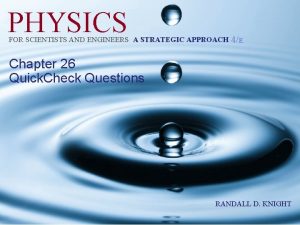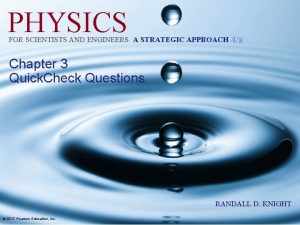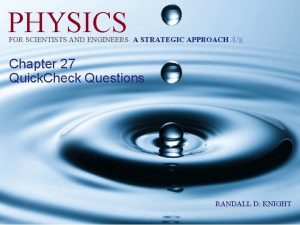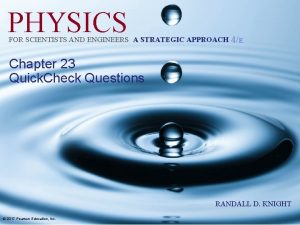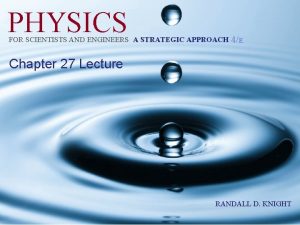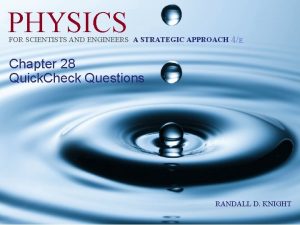PHYSICS FOR SCIENTISTS AND ENGINEERS A STRATEGIC APPROACH























- Slides: 23

PHYSICS FOR SCIENTISTS AND ENGINEERS A STRATEGIC APPROACH 4/E Chapter 7 Quick. Check Questions RANDALL D. KNIGHT © 2017 Pearson Education, Inc.

Quick. Check 7. 1 A mosquito runs head-on into a truck. Splat! Which is true during the collision? A. B. C. D. E. The mosquito exerts more force on the truck than the truck exerts on the mosquito. The truck exerts more force on the mosquito than the mosquito exerts on the truck. The mosquito exerts the same force on the truck as the truck exerts on the mosquito. The truck exerts a force on the mosquito but the mosquito does not exert a force on the truck. The mosquito exerts a force on the truck but the truck does not exert a force on the mosquito. © 2017 Pearson Education, Inc. Slide 7 -2

Quick. Check 7. 1 A mosquito runs head-on into a truck. Splat! Which is true during the collision? A. B. C. D. E. The mosquito exerts more force on the truck than the truck exerts on the mosquito. The truck exerts more force on the mosquito than the mosquito exerts on the truck. The mosquito exerts the same force on the truck as the truck exerts on the mosquito. The truck exerts a force on the mosquito but the mosquito does not exert a force on the truck. The mosquito exerts a force on the truck but the truck does not exert a force on the mosquito. © 2017 Pearson Education, Inc. Slide 7 -3

Quick. Check 7. 2 A mosquito runs head-on into a truck. Which is true during the collision? A. B. C. D. E. The magnitude of the mosquito’s acceleration is larger than that of the truck. The magnitude of the truck’s acceleration is larger than that of the mosquito. The magnitude of the mosquito’s acceleration is the same as that of the truck. The truck accelerates but the mosquito does not. The mosquito accelerates but the truck does not. © 2017 Pearson Education, Inc. Slide 7 -4

Quick. Check 7. 2 A mosquito runs head-on into a truck. Which is true during the collision? A. B. C. D. E. The magnitude of the mosquito’s acceleration is larger than that of the truck. The magnitude of the truck’s acceleration is larger than that of the mosquito. The magnitude of the mosquito’s acceleration is the same as that of the truck. The truck accelerates but the mosquito does not. The mosquito accelerates but the truck does not. Newton’s second law: Don’t confuse cause and effect! The same force can have very different effects. © 2017 Pearson Education, Inc. Slide 7 -5

Quick. Check 7. 3 What, if anything, is wrong with these free-body diagrams for a truck towing a car at steady speed? The truck is heavier than the car and the rope is massless. A. B. C. D. E. Nothing is wrong. One or more forces have the wrong length. One of more forces have the wrong direction. One or more action/reaction pairs are wrong. Both B and D. © 2017 Pearson Education, Inc. Slide 7 -6

Quick. Check 7. 3 What, if anything, is wrong with these free-body diagrams for a truck towing a car at steady speed? The truck is heavier than the car and the rope is massless. A. B. C. D. E. Nothing is wrong. One or more forces have the wrong length. One of more forces have the wrong direction. One or more action/reaction pairs are wrong. Both B and D. © 2017 Pearson Education, Inc. Slide 7 -7

Quick. Check 7. 4 A car is parked at rest on a horizontal road. The upward force of the road on the car (the normal force) is the same size as the downward pull of gravity A. B. C. D. Because they are an action/reaction pair. Because of Newton’s first law. Both A and B. Neither A nor B. Some other reason. © 2017 Pearson Education, Inc. Slide 7 -8

Quick. Check 7. 4 A car is parked at rest on a horizontal road. The upward force of the road on the car (the normal force) is the same size as the downward pull of gravity A. B. C. D. Because they are an action/reaction pair. Because of Newton’s first law. Both A and B. Neither A nor B. Some other reason. © 2017 Pearson Education, Inc. Slide 7 -9

Quick. Check 7. 5 Boxes A and B are being pulled to the right on a frictionless surface. Box A has a larger mass than B. How do the two tension forces compare? A. B. C. D. T 1 > T 2 T 1 = T 2 T 1 < T 2 Not enough information to tell. © 2017 Pearson Education, Inc. Slide 7 -10

Quick. Check 7. 5 Boxes A and B are being pulled to the right on a frictionless surface. Box A has a larger mass than B. How do the two tension forces compare? A. B. C. D. T 1 > T 2 T 1 = T 2 T 1 < T 2 Not enough information to tell. © 2017 Pearson Education, Inc. Slide 7 -11

Quick. Check 7. 6 Boxes A and B are sliding to the right on a frictionless surface. Hand H is slowing them. Box A has a larger mass than B. Considering only the horizontal forces, A. FB on H = FH on B = FA on B = FB on A B. FB on H = FH on B > FA on B = FB on A C. FB on H = FH on B < FA on B = FB on A D. FH on B = FH on A > FA on B © 2017 Pearson Education, Inc. Slide 7 -12

Quick. Check 7. 6 Boxes A and B are sliding to the right on a frictionless surface. Hand H is slowing them. Box A has a larger mass than B. Considering only the horizontal forces, A. FB on H = FH on B = FA on B = FB on A B. FB on H = FH on B > FA on B = FB on A C. FB on H = FH on B < FA on B = FB on A D. FH on B = FH on A > FA on B © 2017 Pearson Education, Inc. Slide 7 -13

Quick. Check 7. 7 All three 50 -kg blocks are at rest. The tension in rope 2 is A. greater than the tension in rope 1. B. equal to the tension in rope 1. C. less than the tension in rope 1. © 2017 Pearson Education, Inc. Slide 7 -14

Quick. Check 7. 7 All three 50 -kg blocks are at rest. The tension in rope 2 is A. greater than the tension in rope 1. B. equal to the tension in rope 1. C. less than the tension in rope 1. Each block is in static equilibrium, with © 2017 Pearson Education, Inc. . Slide 7 -15

Quick. Check 7. 8 The two masses are at rest. The pulleys are frictionless. The scale is in kg. The scale reads A. B. C. 0 kg. 5 kg. 10 kg. © 2017 Pearson Education, Inc. Slide 7 -16

Quick. Check 7. 8 The two masses are at rest. The pulleys are frictionless. The scale is in kg. The scale reads A. B. C. 0 kg. 5 kg. 10 kg. © 2017 Pearson Education, Inc. Slide 7 -17

Quick. Check 7. 9 The acceleration constraint here is A. a. Ay = a. By B. –a. Ay = –a. By C. a. Ay = –a. By D. a. By = –a. Ay E. Either C or D. © 2017 Pearson Education, Inc. Slide 7 -18

Quick. Check 7. 9 The acceleration constraint here is A. a. Ay = a. By B. –a. Ay = –a. By C. a. Ay = –a. By D. a. By = –a. Ay E. Either C or D. © 2017 Pearson Education, Inc. Either says that the acceleration vectors point in opposite directions. Slide 7 -19

Quick. Check 7. 10 The top block is accelerated across a frictionless table by the falling mass m. The string is massless, and the pulley is both massless and frictionless. The tension in the string is A. T < mg B. T = mg C. T > mg © 2017 Pearson Education, Inc. Slide 7 -20

Quick. Check 7. 10 The top block is accelerated across a frictionless table by the falling mass m. The string is massless, and the pulley is both massless and frictionless. The tension in the string is A. T < mg B. T = mg C. T > mg © 2017 Pearson Education, Inc. Tension has to be less than mg for the block to have a downward acceleration. Slide 7 -21

Quick. Check 7. 11 Block A is accelerated across a frictionless table. The string is massless, and the pulley is both massless and frictionless. Which is true? A. Block A accelerates faster in case a than in case b. B. Block A has the same acceleration in case a and case b. C. Block A accelerates slower in case a than in case b. © 2017 Pearson Education, Inc. Slide 7 -22

Quick. Check 7. 11 Block A is accelerated across a frictionless table. The string is massless, and the pulley is both massless and frictionless. Which is true? A. Block A accelerates faster in case a than in case b. B. Block A has the same acceleration in case a and case b. C. Block A accelerates slower in case a than in case b. © 2017 Pearson Education, Inc. Slide 7 -23
 Strategic complement
Strategic complement Industrial organization model of above average returns
Industrial organization model of above average returns Cultural aspects of strategy choice
Cultural aspects of strategy choice Difference between virtual and datagram circuit
Difference between virtual and datagram circuit Deep learning approach and surface learning approach
Deep learning approach and surface learning approach Strategic fit vs strategic intent
Strategic fit vs strategic intent Incremental approach in strategic management
Incremental approach in strategic management Strategic control
Strategic control Strategic choice approach
Strategic choice approach A strategic approach to software testing
A strategic approach to software testing Strategic management a competitive advantage approach
Strategic management a competitive advantage approach A strategic approach to software testing
A strategic approach to software testing Crescive approach
Crescive approach After the experiment scientists organize and the data
After the experiment scientists organize and the data Diagrams tables and graphs are used by scientists mainly to
Diagrams tables and graphs are used by scientists mainly to Modern physics vs classical physics
Modern physics vs classical physics University physics with modern physics fifteenth edition
University physics with modern physics fifteenth edition Ia physics examples
Ia physics examples Fspos vägledning för kontinuitetshantering
Fspos vägledning för kontinuitetshantering Typiska novell drag
Typiska novell drag Tack för att ni lyssnade bild
Tack för att ni lyssnade bild Ekologiskt fotavtryck
Ekologiskt fotavtryck Varför kallas perioden 1918-1939 för mellankrigstiden
Varför kallas perioden 1918-1939 för mellankrigstiden En lathund för arbete med kontinuitetshantering
En lathund för arbete med kontinuitetshantering









